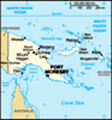Advertisement
Published: March 11th 2014
9
th March Rabaul, Papua New Guinea
This is a maiden port of call for the Queen Elizabeth and was meant to be a tender, however for some reason a berth became available in Simpson Harbour and we docked at about 8 am on this glorious Sunday morning.
This was from the sublime (Airlie Beach) with all its fancy yachts and infrastructure to the ridiculous (Rabaul) a township struggling to survive.
Rabaul sits in part of the volatile ‘Ring of Fire’ and suffered its last eruption in 1994. Over 80%!o(MISSING)f buildings were destroyed during this time and after the eruption the capital was moved to Kokopo about 12 miles away. The violent eruptions of Mt Tavurvur followed by Mt Vulcan on the other side of Simpson Harbour quickly buried the eastern side of Rabaul (and remains buried) under several feet of black volcanic ash. Mt Tavurvur is extremely active and we saw on arrival great plumes of smoke and ash. Perhaps the gods were angry that we had arrived on a Sunday.
Rabauls history has included twice being severely damaged by volcanic eruptions (1937 & 1994) as
well as being bombed by allied forces during the Japanese occupation in WWII. After the 1937 eruption, Rabaul was rebuilt only to find that in 1942, Japanese troops overcame the small Australian garrison who stood no chance against superior forces.
Japan turned Rabaul into a fortress, tunnels were dug into the pumice hills using slave labour, and the largest included a hospital capable of treating 2500 patients. Almost 100,000 troops were stationed here and the infrastructure included 5 airstrips, submarine and seaplane bases and a large number of naval ships in Simpson harbour. Rabaul was subject to frequent air raids and the harbour is littered with the wrecks of more than 50 Japanese vessels ranging from freighters to warships.
Before the 1994 eruption Rabaul was a popular commercial and recreational boating destination and there are still several diving operations based here. Tourism is yet to recover to its pre-eruption levels and it is difficult to imagine how it will do so.
It seems that the main tourists will come in by cruise liner. At the moment they have approximately 6 cruise ships a year. The Rabaul airfield was destroyed in the
last eruption and there are no plans to build a new one as it lies under several feet of volcanic ash.
The main transport for our trip for the highlights was by PMV (Public Motor Vehicle). These minivans take up to 12 people so there were quite a number on the wharf. The tour operators were pretty good in getting them all full before we set off.
The first visit took us out of the town off the tarmac roads towards the base of the volcano to some hot springs. Once we were off the metalled roads we drove along tracks of volcanic ash marked out with sticks/rags to approach the volcanoes, the Matupit people live right underneath this active volcano, quite amazingly considering the risks. These people welcome visitors and are friendly and cheerful. The tracks we travelled on went past the old airport which was unrecognisable excepting for the flatness and the occasional roof (gable end) sticking out. At the springs the locals had set up stalls to sell their trinkets which ranged from necklaces, coconut and lava carvings to printed tea towels and PNG hats!!
The lagoon in
this area did not support any marine life because of the sulphur and the palm trees close to the area whilst having signs of fruit were actually sterile i.e. there were no fruits inside. A meagre existence.
From here we drove back through the town to just outside Rabaul where the Volcanology Observatory is situated on a hilltop, the only one in the area. This observatory measures the seismic activity from Mt Tavurvur and the surrounding Rabaul caldera. On the way up to the hilltop we passed the tunnels dug by the Japanese to escape the bombing from the Allies.
Our final visiting point was the old submarine base at Tavui point; the submarines would be replenished by barges kept in underground tunnels. The submarines moored at the edge of the reef in deep water so they could dive if attacked. There were also the old Japanese gun placements here.
It’s amazing how resilient people are, as with other parts of the world with nearby volcanoes – life goes on. The port is a natural deep harbour and is still in business and new industries have been attracted to the area.
The relics and the lure of volcanoes are attractions for the tourists.
All in all a small snapshot of a people that take what nature throws at them and adapt to life’s changes.
A very religious community, that came out on a Sunday to greet us with smiles. I hope after we left they all went to their churches to pray to the ‘Volcano Gods’ to keep them safe and that we hadn’t angered the ‘Gods’ too much.
There were a couple of ‘puffs’ from Mt Tavurvu as we sailed away!!
Next stop Kagoshima, Japan
Advertisement
Tot: 0.641s; Tpl: 0.013s; cc: 21; qc: 77; dbt: 0.1082s; 1; m:domysql w:travelblog (10.17.0.13); sld: 1;
; mem: 1.2mb















